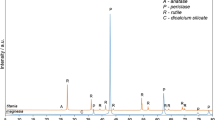Conclusions
We determined the conditions for which hydration of magnesium oxide is diminished so much that it is possible to make porous articles measuring 200×120×50 mm and with an apparent density of 0.5–2.0 g/cm3, or higher, using the foam method and water suspensions.
The porous ceramics made from magnesium oxide by the foam method with the same apparent density are distinguished by the much greater compressive strength compared with ceramics made by combustible additive methods.
With increase in apparent density of the porous articles made from magnesium oxide, the thermal shock resistance is also increased.
Similar content being viewed by others
Literature cited
I. Ya. Guzman, G. A. Servoa, Ogneupory, No. 6, 281 (1964).
D. N. Poluboyarinov et al., Ogneupory, No. 2, 80 (1961).
A. A. Pirogov, Ogneupory, No. 2, 79 (1959).
A. E. Makenchik, Ogneupory, No. 5, 194 (1963).
Author information
Authors and Affiliations
Additional information
Translated from Ogneupory, No. 2, pp. 50–53, February, 1968.
Rights and permissions
About this article
Cite this article
Nosova, Z.A., Lyubina, T.M. Magnesia foamed ceramics. Refractories 9, 113–115 (1968). https://doi.org/10.1007/BF01286364
Issue Date:
DOI: https://doi.org/10.1007/BF01286364




